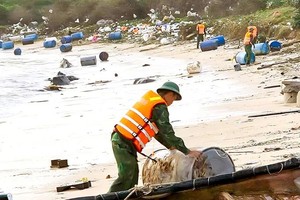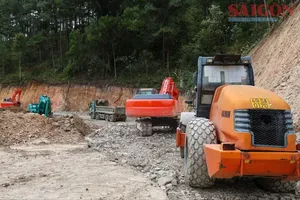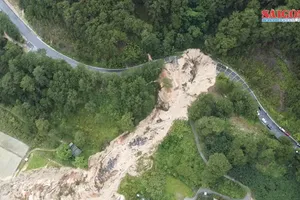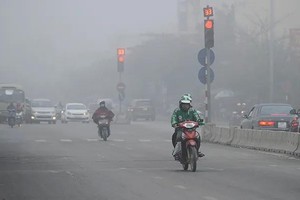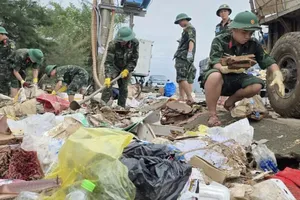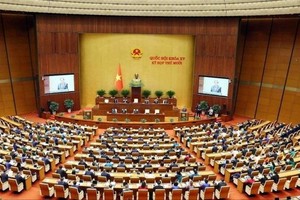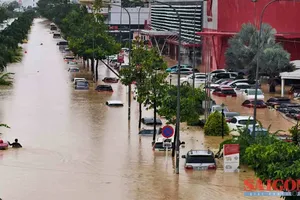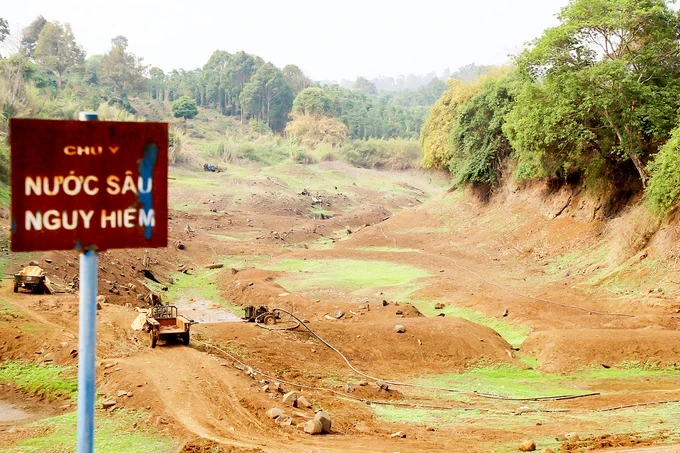
Under the relentless midday sun, Pham Van Phu of Dak Lao Commune (in Dak Mil District, Dak Nong Province), toils at the bottom of the dried Dak M’Bai irrigation reservoir. He is clinging to the faint hope of tapping into residual groundwater to rescue his wilting durian orchard.
The once-expansive Dak M’Bai reservoir is now reduced to a mere puddle, and the shoreline is littered with silent, idle water pumps, rendered useless by the absence of water. Phu laments that the reservoir ran dry in late February 2025, mirroring the depletion of local wells and boreholes. His durian trees, in their crucial flowering stage, face critical damage from water scarcity.
In a nearby location, only Nguyen Thanh Son’s pump breaks the silence at Dak M’Bai. To keep it operational, he is forced to purchase water hourly from a well over a kilometer away, relaying it with two pumps in tandem.
“I'm buying water by the hour, using two pumps to boost the flow, one from the well to the reservoir, then another to my coffee orchard. It’s an exorbitant expense, but it’s the only way to save my crop,” Son says. He points out that the Dak M’Bai reservoir, designed for 70ha, now serves over 100, leading to chronic water shortages. Furthermore, neglect has left the reservoir’s infrastructure in disrepair, hindering its ability to retain water during the rainy season, leaving residents with only one or two rounds of irrigation before it empties.
Heading towards the equally dried Reservoir 40 in Dak Lao Commune, the scene is a stark tableau of cracked earth and haphazard digging. Dozens of pumps stand idle on the shoreline, testament to the reservoir's complete depletion.
Reservoir 40, once a vital water source for Dak Lao, is now barren. Ta Duy Thong from Dak Tho Village of Dak Mil District watched his two-hectare coffee plantation wither, his hands tied. He explained that his livelihood depends on Reservoir 40, but it had dried up before he could complete the critical second round of irrigation.
He and two neighbors are now forced to truck in water from 1.5km away. Locals recount that a brief diversion of water from West Lake offered temporary relief, but the influx was quickly drained by the simultaneous operation of over 20 pumps. With the third round of irrigation overdue, many coffee plantations are currently succumbing to the drought.
Chairman Truong Xuan Hung of the Dak Lao Commune People’s Committee reported that six out of seven local reservoirs are now dry. If rain does not arrive soon, 700ha of industrial crops will suffer, impacting yields. The commune and irrigation authorities are implementing temporary measures, such as rotational water distribution, but these measures will be insufficient if the drought persists.
According to the Dak Mil District Agriculture and Environment Department, reservoir water levels were at a mere 42 percent by March 27, with nine irrigation systems completely dry. Should the heatwave continue, communes like Dak Lao, Dak N’Drot, Dak Gan, and Dak R’la face dire water shortages.
In Dak Lak Province, similar water shortages are impacting crops. A senior official from the Provincial Department of Agriculture and Environment noted a steady decline in river and stream levels since the start of the year, with some smaller waterways at risk of total waterlessness, leading to localized droughts.
An estimated 4,500ha of short-term crops, primarily rice, will be affected, concentrated in districts like Buon Don, Lak, Ea Sup, Krong Pak, Krong Ana, Cu Kuin, and Cu M’gar. For long-term crops like coffee, pepper, and fruit trees, the affected area is projected at 1,500ha, mainly in Krong Buk, Krong Nang, Buon Don, Cu M’gar, and Buon Ho town.
By mid-April 2025, if rain fails to materialize, most dams and reservoirs across the province will reach dead water levels. Therefore, it is necessary to develop drought mitigation plans and urge residents to conserve water to extend irrigation through the dry season.



